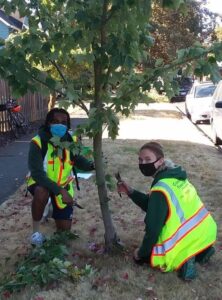Tag: tree care and equity
Get to Know our pruning program – 2,000 trees pruned this season!

Pruning trees contributes to a more equitable community. Or, more accurately, pruning trees at no cost contributes to a more equitable, livable community.
How? We’ve learned that a major barrier to many households getting a street tree is the cost of maintaining the tree. Pruning can be very expensive, and it gets more expensive as the tree ages and grows if problems are not addressed early. Properly pruning a tree when young is an excellent investment and can delay or even prevent future expenses, making a tree more affordable. Pruning young trees at no cost by trained Friends of Trees volunteers is one important way to help get more trees into more neighborhoods, especially under-served, low-income communities which are often communities of color impacted by systemic disparities. That is exactly why Friends of Trees is focusing efforts on specifically those communities who will benefit the most.
Our pruning program also benefits youth through our educational partnerships. While we are pruning trees we are also training young people to prune. Through partnerships with organizations like Rosemary Anderson HS POIC, student interns in our pruning program earn an hourly stipend while building valuable job skills. Pruning skills can be developed and honed in preparation for becoming an ISA-certified arborist – a very solid living with excellent job security. Added bonus: Exposing young people to the benefits of trees and tree care contributes to a greater appreciation of trees and nature, helping to grow the next generation’s Tree Team.
Pruning = longer lived, healthier trees = healthier planet + people. The benefits of trees—oxygen creation, pollution and stormwater absorption, healthier humans (DYK that trees help combat cardiac and respiratory ailments and can even contribute to increased birthweights?), and so much more—increase exponentially as trees grow and age. And the earlier a tree is properly pruned, the greater the chance it will grow to a ripe old age benefitting neighborhoods and the planet for generations to come.
Pruning for structure (shape) and clearance (sidewalks and streets) is the primary way to steward and care for a tree post-establishment. Proper pruning contributes to the long-term health of the tree, while lack of pruning, or pruning incorrectly, will contribute to the premature demise of the tree. Pruning in the built environment (as opposed to a natural setting) is also key to preventing tree-related damage following inclement weather.
There’s another reason pruning young trees is better: It’s easier for the tree to recover from pruning when it’s young than it is when the tree is more mature (trees have to “recover” after any sort of pruning, good or bad, it’s just far more efficient for them to recover from careful “surgery” by a trained pruner as opposed to “natural” pruning by snow/ice + wind). When pruned, a tree immediately gets to work “sealing” the cut, working to close off the wound.
When pruning young trees, we have the opportunity to make a 5-cent cut today to prevent the need for a $100 cut 20 years down the road (or, so the saying kind of goes ;). Not only is it more cost-effective to properly prune young trees, the larger the pruning cut (because the limbs are larger), the longer it takes the tree to recover. A tree can quickly seal and move beyond a ¼” cut made with hand pruners, but it may takes years to recover from an 8” diameter cut made with a chainsaw (and it may never recover at all). BTW, trees don’t actually “heal,” they seal or compartmentalize and – once recovered – they then grow more vigorously.
With all the benefits of pruning it’s a good thing our pruning program is so popular with volunteers (100+ pruning volunteers every year!), since volunteer-power is the only way we’ll be able to prune 2,000 trees this season. Pruning is especially popular right now as it’s pretty pandemic-resistant: pruning is not a large group activity and it takes place 100% outdoors. In fact, it’s because of COVID that this will be the biggest pruning season yet, with a 40% increase in trees pruned over last season! BTW, we’ll prune any young street tree in our service area (6” diameter or smaller), not just the trees we plant – all at no cost (thanks in large part to our partners at City of Portland Bureau of Environmental Services).
Pruning trees properly contributes to the health of the tree and to those who live under its canopy. We of course want the trees we plant to grow and thrive, and proper pruning when young is key to tree health, so pruning is an important part of our Neighborhood Trees program. Need more information? Visit our tree resources page for more information about tree care and the benefits of trees. Ready for a tree of your own? Get started here!
Photo: Youth interns learning to prune, part of our Rosemary Anderson High School/POIC partnership; August 2020.
